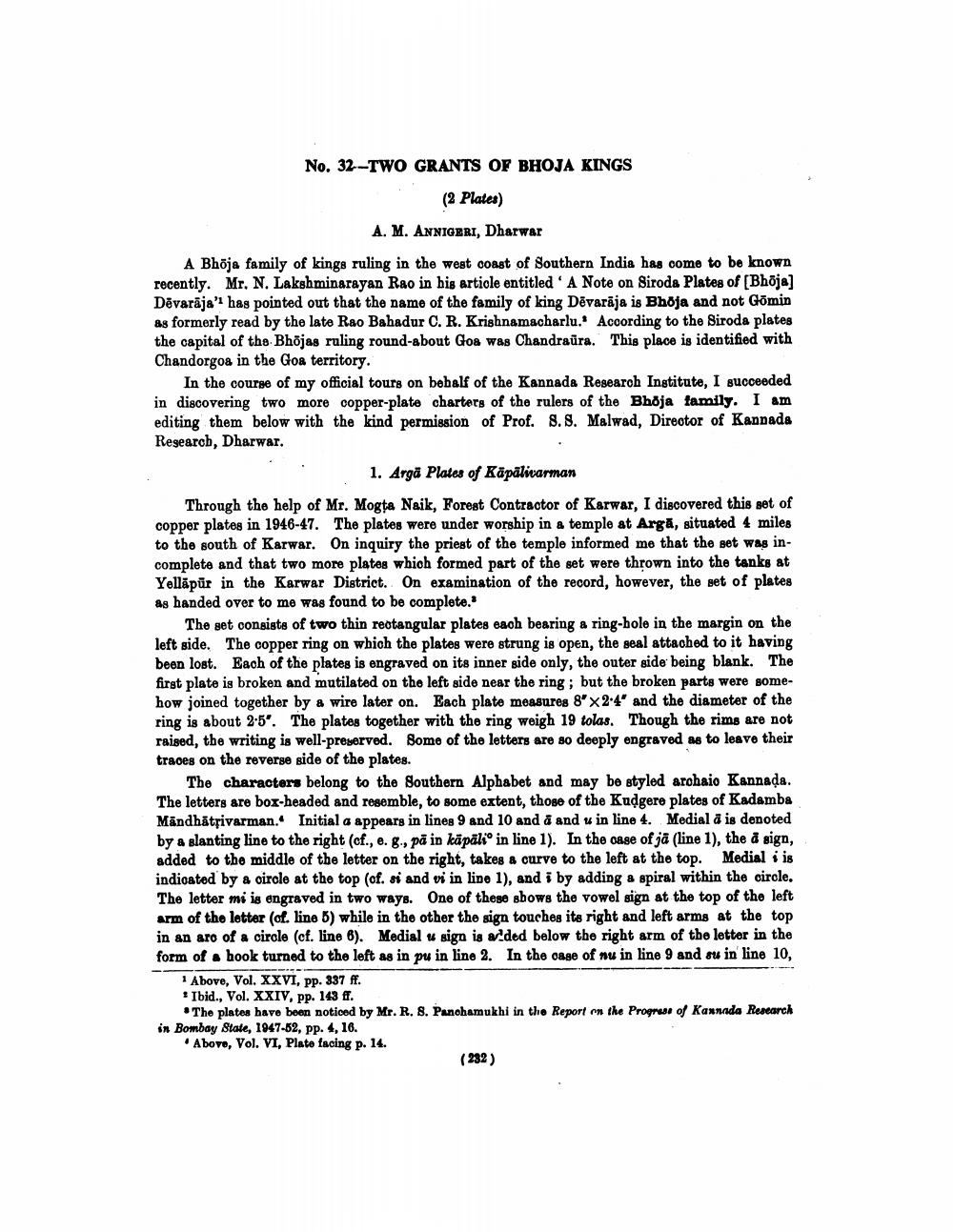________________
No. 32-TWO GRANTS OF BHOJA KINGS
(2 Plates)
A. M. ANNIGERI, Dharwar
A Bhõja family of kings ruling in the west coast of Southern India has come to be known recently. Mr. N. Lakshminarayan Rao in his article entitled 'A Note on Siroda Plates of Bhoja] Dēvarāja'i has pointed out that the name of the family of king Dēvarāja is Bhoja and not Gömin as formerly read by the late Rao Bahadur C. R. Krishnamacharlu. According to the Siroda plates the capital of the Bhõjas ruling round-about Goa Was Chandraūra. This place is identified with Chandorgoa in the Goa territory.
In the course of my official tours on behalf of the Kannada Research Institute, I succeeded in discovering two more oopper-plate charters of the rulers of the Bhðja family. I am editing them below with the kind permission of Prof. 8. 8. Malwad, Director of Kannada Research, Dharwar.
1. Arga Plates of Kāpālivarman Through the help of Mr. Mogta Naik, Forest Contractor of Karwar, I discovered this set of copper plates in 1946-47. The plates were under worship in a temple at Argă, situated 4 miles to the south of Karwar. On inquiry the priest of the temple informed me that the set was incomplete and that two more plates which formed part of the set were thrown into the tanks at Yelläpür in the Karwar District. On examination of the record, however, the set of plates as handed over to me was found to be complete.'
The set consists of two thin rectangular plates each bearing a ring-hole in the margin on the left side. The copper ring on which the plates were strung is open, the seal attached to it having been lost. Each of the plates is engraved on its inner side only, the outer side being blank. The first plate is broken and mutilated on the left side near the ring ; but the broken parts were somehow joined together by a wire later on. Each plate measures 8" X 2'4' and the diameter of the ring is about 2-5'. The plates together with the ring weigh 19 tolas. Though the rims are not raised, the writing is well-preserved. Some of the letters are so deeply engraved as to leave their traces on the reverse side of the plates.
The characters belong to the Southern Alphabet and may be styled archaio Kannada. The letters are box-headed and resemble, to some extent, those of the Kudgere plates of Kadamba Māndhātrivarman. Initial a appears in lines 9 and 10 and á and u in line 4. Medial à is denoted by a slanting line to the right (cf., 6. 8., på in kāpalio in line 1). In the age of jā (line 1), the à sign, added to the middle of the letter on the right, takes a curve to the left at the top. Medial i is indioated by a circle at the top (of. si and vi in line 1), and i by adding a spiral within the circle. The letter mi is engraved in two ways. One of these shows the vowel sign at the top of the left arm of the letter (of. line 5) while in the other the sign touches its right and left arms at the top in an aro of a cirole (cf. line 6). Medial u sign is added below the right arm of the letter in the form of a book turned to the left as in pu in line 2. In the case of nu in line 9 and su in line 10,
1 Above, Vol. XXVI, pp. 337 ff. * Ibid., Vol. XXIV, pp. 143 ff.
• The plates have been noticed by Mr. R. 8. Panchamukhi in the Report on the Progress of Kannada Research in Bombay State, 1947-62, pp. 4, 16. . Abovo, Vol. VI, Plate facing p. 14.
(232)




